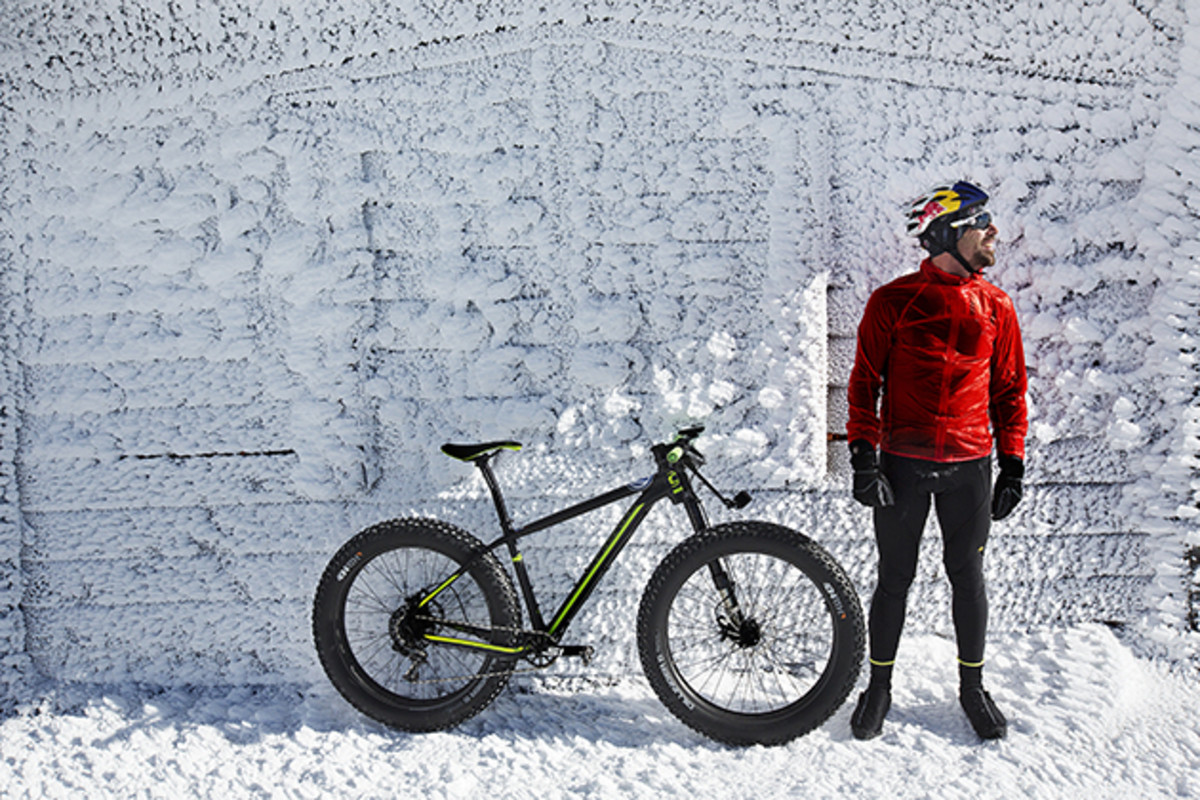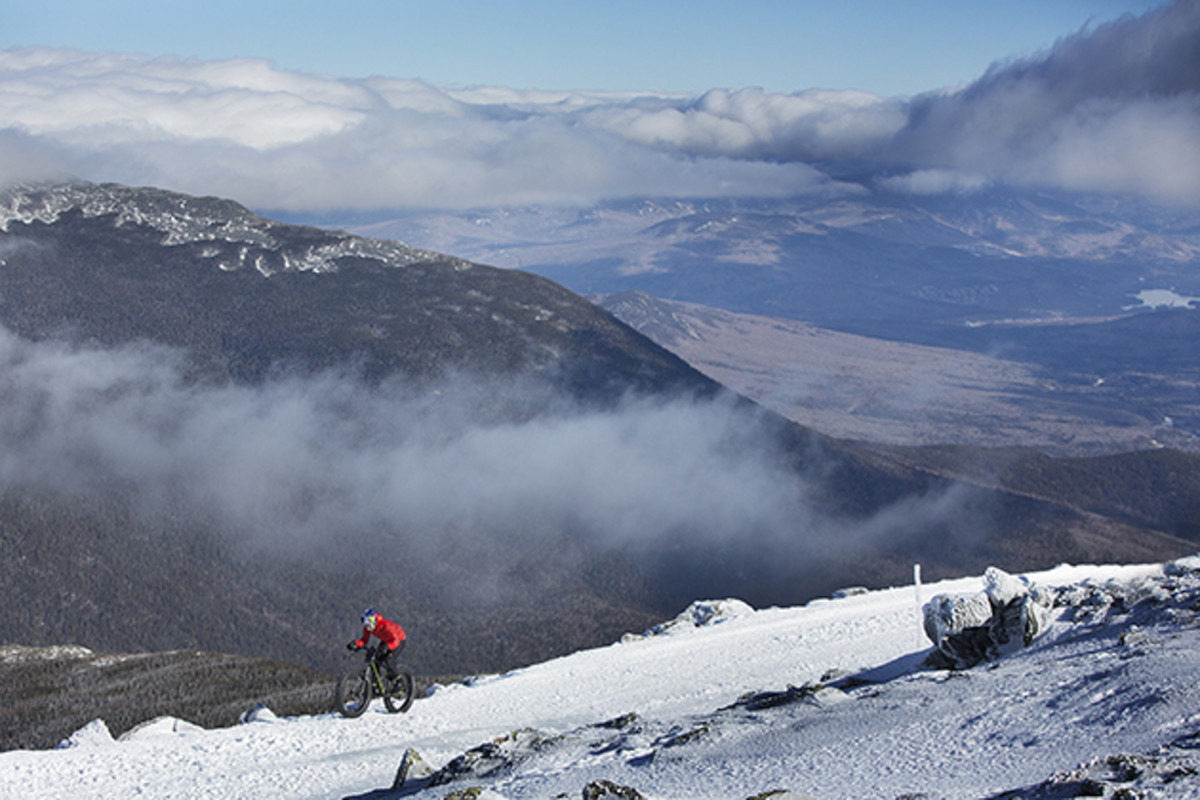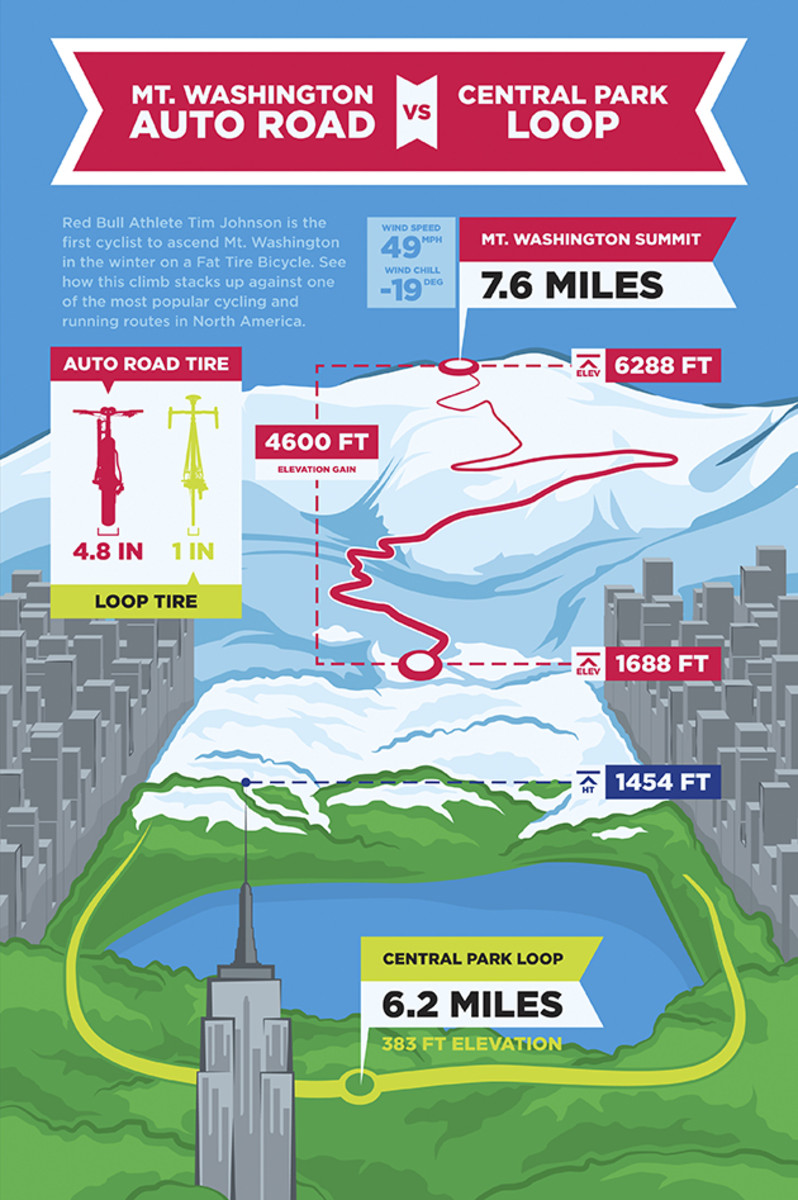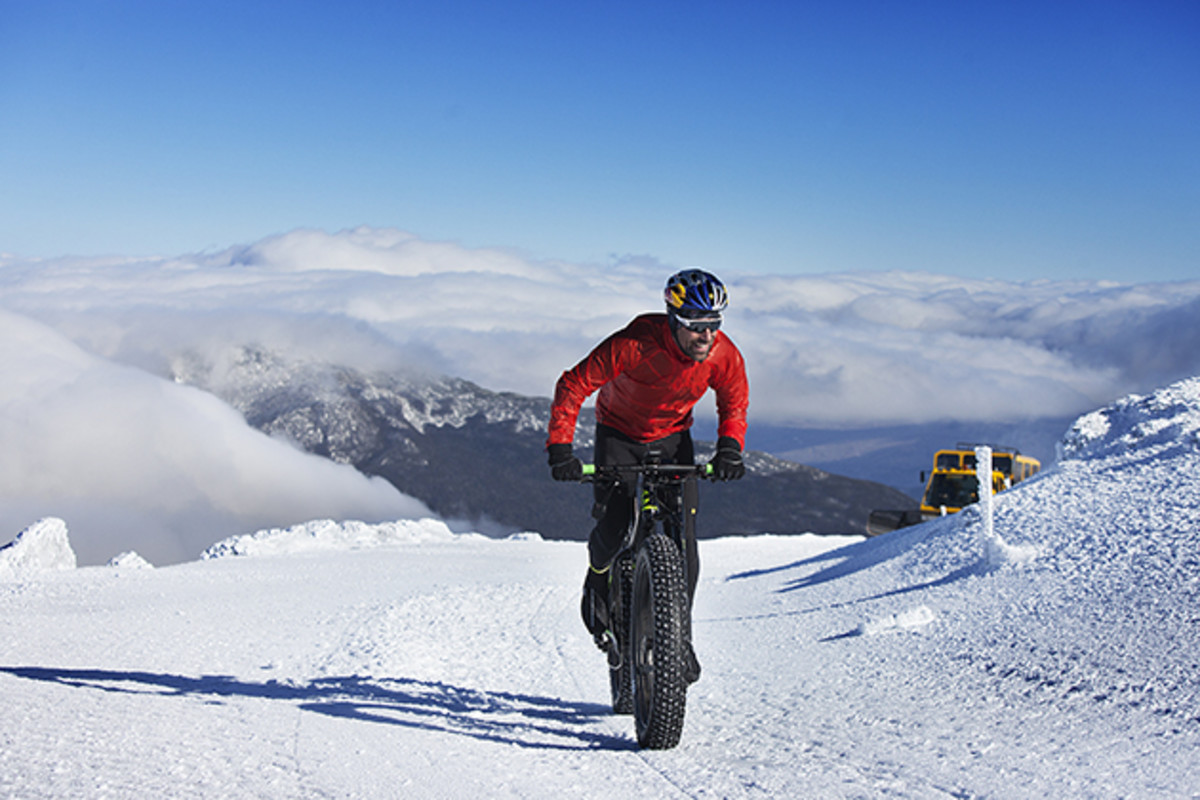Winter Warrior: Cyclist conquers daunting Mt. Washington in winter

Even in August, Mount Washington in upstate New Hampshire is not a place to trifle with. “The Rockpile,” as it is known can—due to its exposure and its situation at the confluence of two major storm tracks—be erratic and dangerous. Though a mere 6,288 feet above sea level, the highest peak in the Northeast is as unpredictable as a Vegas blind date.
Come winter, Mount Washington unveils a dark side that borders on sinister. There have been nearly 150 recorded fatalities on its flanks, including deaths of hikers, skiers, and motorists. Which makes cyclist Tim Johnson’s ride to the summit aboard a fat bike in early February—the first ever mid-winter, two-wheeled ascent of Mount Washington—all the more impressive.

“This is a totally different ballgame, and it’s not something that makes you feel particularly confident or safe,” says the 38-year-old Johnson, a Red Bull-sponsored rider. “People die at Mount Washington all the time, and it could have been a white-out in minutes. We weren’t sure what was going to happen.”
The SI Extra Newsletter Get the best of Sports Illustrated delivered right to your inbox
Subscribe
As a six-time national cyclocross champion, Johnson admits bad weather is his stock-in-trade. But few cyclocross venues can match the Mount Washington Auto Road for sheer, throat-tightening anxiety.
The 155-year-old Mount Washington Auto Road—billed as “America’s First and Oldest Man-made Attraction”—rises 4,270 feet from Pinkham Notch to the summit in a mere 7.6 miles. During the summer months, the road is open only four days to cyclists, during the venerable Mount Washington Auto Road Hillclimb and Newton’s Revenge (a race added to accommodate the overflow from the Hillclimb), and two practice days.

Johnson has raced the Auto Road Hillclimb six times, winning twice, in 2000 and 2001 (the latter in a personal best time of 53 minutes, 31 seconds). Nine years after his second victory, Johnson was back in Pinkham Notch, supporting another Red Bull athlete, rally car racer Travis Pastrana. On a clear September day in 2010, Pastrana charged up the Auto Road aboard his souped-up Subaru WRX in a then-record time of six minutes, 20.47 seconds.
“I had a chance to go up in the helicopter when Travis was going for the record,” said Johnson. “It was amazing, just unbelievable. Having been up there so many times on a bike, I knew just what corners they were talking about. He hit 100 miles an hour on one straightaway. You just can’t imagine that.”
King of the road: Subaru driver David Higgins rules American Rally
But seeing Pastrana’s performance got Johnson thinking about tackling The Rockpile in a different way. That meant a different season. Advances in fat bike technology—spawned by adaptations employed during Alaska’s epic IditaBike race—made the idea of a winter ride even more compelling.
“Anyone who has ever been on the slopes of Mount Washington knows how unique the landscape and how unique the weather is,” says Johnson, a Massachusetts native. “So you really feel like you are somewhere else, and you’re transported there immediately when you start pedaling.”
Johnson and his team had willing partners at the Auto Road and the state’s parks department. Mother Nature was less inclined to play along. The Red Bull crew had targeted early February for Johnson’s bid. In late January, however, the mountain was socked in beneath a low-pressure front, which brought high winds (an average of almost 50 mph, with gusts exceeding 125), biting cold, and precious little visibility.
• MORE EDGE: How Cameron Naasz is training to make ice cross history
However, a staffer at the Mount Washington Observatory kept Johnson’s team apprised of weather updates, and reported that Tuesday, Feb. 2, might bring a favorable change.
“I got in my car on Monday, with my fat bike, and I was just looking at the weather the whole time,” Johnson says. “We made the decision at dinner Monday night. We decided to go for it.”
Fortunately, the prediction held, as a high-pressure front brought milder temperatures (about 30 degrees at the base), lighter winds, and cerulean skies. Johnson rolled up to the starting line at about 9 a.m.
“As soon as you start the climb, it’s hard,” he says. “You don’t have a warm-up. You don’t ease into it. It goes from the parking lot to a wall.”

Unlike Pastrana, who had 400 horsepower to work with in his Subaru, Johnson could call on only the power produced by his legs, lungs, and heart. His rig was a 29-pound modified Cannondale Fat CAAD 1, outfitted with lightweight carbon wheels and 5-inch tires. Each tire was perforated with 258 carbide studs to add some bite on the boilerplate ice that covered portions of the road.
“I could barely stand up on the pedals,” he says. “The ice was just that slick.”
When the ice wasn’t a solid sheet, it was corrugated ripples left from the SnowCoach tracks. While the uneven surface would have been a nightmare for a typical road bike, or even mountain bike, it turned out, Johnson says, to be a blessing for him.
“The cat tracks were a salvation, because I knew I would get traction,” says Johnson. “That’s where the singletrack feel comes in. If you were to get my actual path that I rode on, I was back and forth, one side of the road to the other, all the way up. If I didn’t do that, I would fall over.
“I stopped a couple of times, and I couldn’t pedal. And I couldn’t stand on the ice. So I had to kind of skip over to the other side of the road to get my feet into something soft, and then I could start pedaling again.”
Above treeline, wind also played a significant factor. The average wind speed was roughly 30 mph, with gusts upwards of 50. During a reconnaissance outing, Johnson’s Red Bull camera crew got a rude welcome from The Rockpile.
Ayumu Hirano Q&A: Enjoying success in 2016, off-season grind, more
“The day before, our camera guy got out of the [SnowCoach] at the top,” says Johnson. “He had never been there before—he flew in from Utah—and wanted to check out the scenery. He steps out of the cat’s cabin, takes a couple of steps, slips, and the wind blows him a hundred yards. That set the tone for the camera crew. At that point, they knew that they were in trouble.”
Despite having a solid support crew, Johnson knew he was solely responsible for getting to the summit.
“If I did have a crash that turned into a slide off the top of the mountain, I knew that I’d probably end up OK, because the [SnowCoach] was there," he says. “But you never know. It’s as close as we get to mountain climbing on a bike.
“It wasn’t just me, alone, but no one was going to help me pedal. And no one was going to help me get traction where there wasn’t traction.”
There’s also an undeniable mental component to any Auto Road ascent. The pitch, ranging from an average 12% grade to a ridiculously steep 22% at the summit, is unrelenting. Around each of its 72 corners, the road continues to climb. There are no flat sections, no plateaus, for recovery. Combined with the ubiquitous winds above treeline, the road is an immense test of fortitude.
“It’s like instant ice cream headache, freezing your hands, freezing your feet,” Johnson says. “Once you get above treeline, there’s no protection from the wind at all.”
Typically, a race like the Mount Washington Auto Road Hillclimb demands a strict regimen focusing on training and preparation, allowing competitors to keep emotions in check. But the Mount Washington ride, with “so many variables, so many unknowns,” was far less predictable, says Johnson. The winter ride took him on an emotional rollercoaster that he hadn’t anticipated. It brought him face to face with his father.
“I felt kind of exposed anyway,” Johnson says. “The day before, driving up there, I started to realize where I was going. I was going to Mount Washington, where my dad and I spent a lot of time together, where he had been to my Hillclimb races. And it really just started to get really really, really deep within me.”
Roger Johnson passed away in 2008, “in the middle of my career, and just after a real reconciliation after we had been apart for a while,” says Johnson.
“When I first did Mount Washington, I was a mountain biker,” he says. “My dad and I, we’d pile into his car and drive up to Mount Washington for the race. That was a pretty unique experience when I was an amateur coming up through the ranks.”
Unlike the mid-summer Auto Road Hillclimb, Johnson’s mid-winter ascent wasn’t a competition against other riders. The elements, and Johnson’s motivation, were worlds apart.

“So I really had to think about why I was doing it,” he says. “And doing it with my dad in mind was something that really helped me. It’s something that really became a powerful driver for me. After having done the hundreds and hundreds of races during my career, to have that [relationship] so front and center, as opposed to a placing or a time, was really different.”
Johnson reached the summit less than two hours later. His official time was one hour, 45 minutes and 48 seconds. Subtracting the time required for photo shoots, gear adjustments and a bathroom break, Johnson estimates his riding time was roughly one hour, 33 minutes.
After finishing, the rider pedaled around the summit on his fat bike for a few more photo opportunities. Johnson then took a moment to look out over Wildcat ski area to the east, to remember his father, just as a large cloud descended on The Rockpile, creating a blinding white-out.
“I could hear the photographer yelling, ‘We're done,’” he says.
“Yup,” replied Johnson, with a big grin.
He had done what he came to do.
